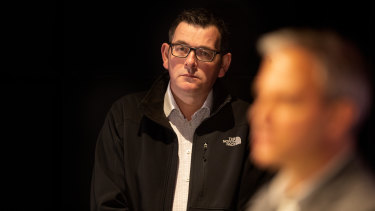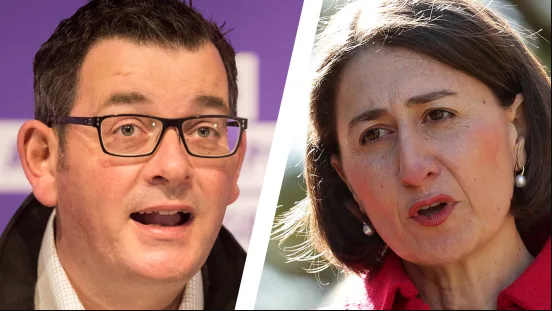Dramatic decision to shut border for first time in 100 years as Victoria’s cases surge
- by Noel Towell, Michael Fowler and Alexandra Smith
The NSW-Victoria border will close at midnight on Tuesday as Victoria’s second surge in the COVID-19 crisis intensifies.
Victorian Premier Daniel Andrews announced the historic decision on Monday morning, as the state recorded its highest-ever daily increase in cases, 127, and a man in his 90s died of the virus in hospital overnight.
There are 645 Victorians ill with COVID-19, up from 125 active cases two weeks ago.
The dramatic decision to shut the border for the first time in 100 years was made at an early-morning hook-up between Mr Andrews, NSW Premier Gladys Berejiklian and Prime Minister Scott Morrison on Monday.
Ms Berejiklian revealed that it was her state’s health advice to implement the border closure, which will be policed by NSW authorities.
Mr Andrews said he was grateful that NSW would take on the resource burden of managing the closure.
“We have got quite a bit to go on with at the moment and that’s where our focus and energies have been … and will remain,” the Premier said.
The Premier said a ‘permit system’ would allow residents of border communities, like Albury-Wodonga to pass between the the two states to go to work, study or undertake other essential business.
Ms Berejiklian said NSW police were already at border crossings to prevent residents from Melbourne’s 12 ‘hotspot’ postcodes from entering the state.
From 11.59pm on Monday, travellers from anywhere in Melbourne will be barred from crossing the border, before the ban extends to all Victorians at 11.59pm on Tuesday.
“While I do appreciate it is an inconvenience for some people, I don’t think today’s announcement will surprise anyone, given what is happening in Victoria,” Ms Berejiklian said.
“There will always be exemptions, so we do anticipate there will be some flights and passenger trains.”
NSW Chief Health Officer Kerry Chant urged her government to act at 8am on Monday.
“Based on the fact that we have seen increasing cases, extending outside the hotspot areas and recognising … there is often a lag between when cases are recognised and diagnosed, I felt like we needed to get ahead of the potential spread,” Dr Chant said.
NSW Police Commissioner Mick Fuller said he was conscious of the “enormity” of closing the border, given the number of crossings and local government areas.
“We know there are four primary road crossings, 33 bridges, two waterway crossings and multiple smaller roads,” Mr Fuller said.
“The task is not lost on me in terms of the enormity of the logistics of this operation. There are 11 local government areas and five police districts, which will all have to pull together to make sure this operation is a success.”
















